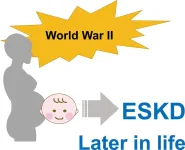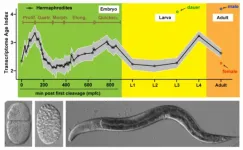(Press-News.org) Women working in healthcare who are regularly exposed to radiation from x-rays and other imaging procedures need better ionising radiation protection to help minimise their risk of developing breast cancer, argue doctors in The BMJ today.
Ionising radiation is a known human carcinogen and breast tissue is highly radiation sensitive. As such, there are concerns that regular exposure to ionising radiation during image guided procedures may be linked to a higher risk of breast cancer in female healthcare workers.
Personal protective equipment (PPE) such as lead gowns are used to shield the body from harmful radiation during these procedures. But studies have shown that current radiation PPE provides inadequate protection to breast tissue as it leaves the area close to the armpit (known as the upper outer quadrant and axilla - the most common site of breast cancer) exposed.
“Providing adequate breast covering PPE could therefore reduce radiation exposure and potentially help prevent breast cancer in female healthcare workers,” write Isobel Pilkington and colleagues.
They acknowledge that measuring the risk of occupational radiation induced breast cancer in women working in healthcare is challenging, but as the number of female trainees entering these specialties increases, they say “it is essential that the available evidence is considered and equipment provision improved to minimise this risk.”
They point to observational evidence suggesting an increase in breast cancer risk among female US orthopaedic surgeons compared with an age matched female population, and to a small Finnish study showing breast cancer at 1.7 times the expected rate in radiologists, surgeons, and cardiologists compared with female physicians not working with radiation.
In a study using artificial female torsos to measure radiation exposure, researchers found inadequate upper outer quadrant protection and no statistically significant reduction in dose when standard PPE was compared with a torso without PPE.
Occupational radiation exposure has not been identified as a risk factor for male breast cancer. However, the Ionising Radiation Regulations 2017 state that the radiation dose delivered to all workers should be As Low As Reasonably Achievable (ALARA). The most effective way to achieve this, say the authors, is by reducing the duration of exposure, increasing the distance from the source, and shielding all workers with effective PPE.
They point to additional protection, such as capped sleeves and axillary wings, that can be worn under standard gowns to protect the upper outer quadrant of the breast, and say the European Society for Vascular Surgery 2023 Clinical Practice Guidelines on Radiation Safety have already recommended female operators consider adopting this extra protection.
“Providing appropriate protection is a legal requirement of an employer, who has a duty of care to all workers exposed to radiation,” they write. “The female breast appears to be particularly vulnerable and it is therefore important employers invest in protective equipment that enhances the safety of all their staff.”
[Ends]
END
Female healthworkers need better radiation protection to minimise breast cancer risk
Standard PPE does not fully protect breast tissue; Employers should invest in equipment that ensures the safety of all their staff
2023-04-13
ELSE PRESS RELEASES FROM THIS DATE:
Higher dose corticosteroids associated with a 60% increased risk of death in hypoxic COVID-19 patients requiring only non-invasive oxygen therapy (The Lancet / RECOVERY trial)
2023-04-13
*Note: this is a joint press release from the European Congress of Clinical Microbiology & Infectious Diseases (ECCMID) and The Lancet. Please credit both the congress and the journal in your stories*
A new study to be presented at this year’s European Congress of Clinical Microbiology & Infectious Diseases (ECCMID 2023, Copenhagen 15-18 April), and published in The Lancet, shows that, compared with standard care that included low dose corticosteroid use, treating hypoxic COVID-19 patients needing ...
Assisted reproduction kids grow up just fine – but it may be better to tell them early about biological origins, twenty-year study suggests
2023-04-13
Paper available at: https://drive.google.com/drive/folders/1y9GfgYkRdUtwyq6nBhySePTUHZYP6iAj?usp=share_link
Landmark study finds no difference in psychological wellbeing or quality of family relationships between children born by assisted reproduction (egg or sperm donation or surrogacy) and those born naturally at age 20.
However, findings suggest that telling children about their biological origins early – before they start school – can be advantageous for family relationships and healthy adjustment.
The study, by University of Cambridge researchers, is the first to examine the long-term ...
The hidden culprit behind nitrogen dioxide emissions
2023-04-13
Nitrogen dioxide is one of the criteria air pollutants that plays an important role as a precursor gas of fine particulate matter and ozone. NO2 emissions are known to be primarily generated by industrial facilities or vehicle exhausts. Recently, a research team from POSTECH analyzed satellite remote sensing data from the European Space Agency (ESA) and released results showing that food processing facilities and high-rise apartments that are 10 stories or higher are significant sources of NO2 emissions. Their findings have drawn attention from NASA.
A ...
Notable birth cohort effects on the incidence trend of renal replacement therapy in Japan
2023-04-13
Niigata, Japan - A new Japanese study reveals significant birth cohort effects on the incidence trend of ESKD requiring RRT.
“Different birth cohorts may have different levels of exposure to a particular risk factor, which may produce a change in disease incidence for individuals born at a particular time, i.e. a cohort effect,” said Dr. Wakasugi, the corresponding author of the study. “Age-Period-Cohort (APC) analysis, a statistical method to distinguish between age, period, and ...
Time out: We all need a three-day weekend
2023-04-13
As a four-day work week is trialled in countries across the globe, health researchers at the University of South Australia say they’re ‘all in’ when it comes to a long weekend, especially as new empirical research shows that the extra time off is good for our health.
Assessing changes in daily movements before, during and after holidays, researchers found that people displayed more active, healthy behaviours when they were on holiday, even when they only had a three-day break.
Across the 13-month study period, people generally took an average two to three holidays, each being around 12 days. The most common holiday type was ‘outdoor ...
Using a new technique, PESI/MS/MS, to analyze the nutritional compounds in crops
2023-04-13
Anthocyanins are compounds related to the color of plants. They also have beneficial effects on human health and are used as a supplement. Various species of anthocyanins, divided by their molecular shape, are present in plants. Therefore, simple, and rapid, analytical techniques that can distinguish among these species in crops are necessary for breeding and quality assessment. A team of Nagoya University researchers in Japan has used a technique called probe electrospray ionization tandem mass spectrometry (PESI/MS/MS) to analyze anthocyanins in crops. ...
HKU biologists determine the evolutionary age of individual cell types providing critical insights for animal development
2023-04-13
A research team led by Dr Chaogu ZHENG from the School of Biological Sciences at The University of Hong Kong (HKU) has recently made a significant discovery about the evolutionary age of different type of cells in a small animal called Caenorhabditis elegans (C. elegans). By using single-cell transcriptomic data and refined phylostratigraphy, the team determines the transcriptomic age of individual cells, which means they are able to estimate the evolutionary origin of different cells based on the age of the genes expressed in the ...
Coral-eating fish poo may act as ‘probiotics’ for reefs
2023-04-13
Until recently, fish that eat coral — corallivores — were thought to weaken reef structures, while fish that consume algae and detritus — grazers — were thought to keep reefs healthy. But scientists have discovered that feces from grazers leave large lesions on coral, possibly because they contain coral pathogens. By contrast, feces from corallivores may provide a source of beneficial microbes that help coral thrive.
“Corallivorous fish are generally regarded as harmful because they bite the corals,” said Dr Carsten Grupstra of Rice University, ...
New study demonstrates hospital safety climate and organizational characteristics predict healthcare-associated infections and occupational health outcomes
2023-04-13
Arlington, Va., April 13, 2023 – New data published today in the American Journal of Infection Control (AJIC) provide the first published evidence that a positive safety climate and adherence to standard precautions predict key healthcare-associated infection (HAI) and occupational health outcomes among patients and health care workers, respectively. The findings highlight features within hospitals’ organizations and safety climates that could be modified to improve these outcomes.
“Despite the infection prevention and safety benefits associated with standard precautions, generating consistent adherence in the healthcare setting has been ...
Selenium as a predictor of metabolic syndrome in middle age women
2023-04-12
“Recently, optimizing selenium intake in the population to prevent diseases [...] has been an important issue in modern health care worldwide.”
BUFFALO, NY- April 12, 2023 – A new research paper was published in Aging (listed by MEDLINE/PubMed as "Aging (Albany NY)" and "Aging-US" by Web of Science) Volume 15, Issue 6, entitled, “Selenium as a predictor of metabolic syndrome in middle age women.”
Metabolic syndrome (MetS) is a widespread clinical entity that has become almost a global epidemic. Selenium plays an important role in metabolic homeostasis. It has been suggested that it ...
LAST 30 PRESS RELEASES:
Scientists boost cell "powerhouses" to burn more calories
Automatic label checking: The missing step in making reliable medical AI
Low daily alcohol intake linked to 50% heightened mouth cancer risk in India
American Meteorological Society announces Rick Spinrad as 2026 President-Elect
Biomass-based carbon capture spotlighted in newly released global climate webinar recording
Illuminating invisible nano pollutants: advanced bioimaging tracks the full journey of emerging nanoscale contaminants in living systems
How does age affect recovery from spinal cord injury?
Novel AI tool offers prognosis for patients with head and neck cancer
Fathers’ microplastic exposure tied to their children’s metabolic problems
Research validates laboratory model for studying high-grade serous ovarian cancer
SIR 2026 delivers transformative breakthroughs in minimally invasive medicine to improve patient care
Stem Cell Reports most downloaded papers of 2025 highlight the breadth and impact of stem cell research
Oxford-led study estimates NHS spends around 3% of its primary and secondary care budget on the health impacts of heat and cold in England
A researcher’s long quest leads to a smart composite breakthrough
Urban wild bees act as “microbial sensors” of city health.
New study finds where you live affects recovery after a hip fracture
Forecasting the impact of fully automated vehicle adoption on US road traffic injuries
Alcohol-related hospitalizations from 2016 to 2022
Semaglutide and hospitalizations in patients with obesity and established cardiovascular disease
Researchers ‘listen in’ to embryo-mother interactions during implantation using a culture system replicating the womb lining
How changing your diet could help save the world
How to make AI truly scalable and reliable for real-time traffic assignment?
Beyond fragmented markets: A new framework for efficient and stable ride-pooling
Can shape priors make road perception more reliable for autonomous driving?
AI tracks nearly 100 years of aging research, revealing key trends and gaps
Innovative techniques enable Italy’s first imaging of individual trapped atoms
KIER successfully develops Korea-made “calibration thermoelectric module” for measuring thermoelectric device performance
Diversifying US Midwest farming for stability and resilience
Emphasizing immigrants’ deservingness shifts attitudes
Japanese eels, climate change, and river temperature
[Press-News.org] Female healthworkers need better radiation protection to minimise breast cancer riskStandard PPE does not fully protect breast tissue; Employers should invest in equipment that ensures the safety of all their staff





